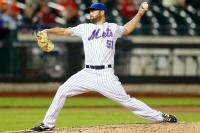Jack Leathersich
There is going to be a lot to be said here and other places about the New York Mets and Carlos Beltran “mutually agreeing to part ways,” but one thing remains clear – the Mets were unwilling to weather the storm and stand by their manager.
Despite the Mets profiting from a Ponzi Scheme and selling the team to a person who has paid the largest ever insider trading fine, this is apparently where they draw the line.
Perhaps, it shouldn’t come as a surprise with Jeff Wilpon having been alleged to fire a pregnant employee because he was not married, but the Mets have stood by their people who have committed violent acts against women.
In 2004, the Arizona Diamondbacks fired Wally Backman before he managed one game after discovering his previous arrests for drunk driving and for a fight with his wife.
He’d be unemployable for Major League teams for years, and he’d have to resort to managing in the independent leagues. Eventually, the Mets brought him back to the organization and gave him a job for six years.
The Mets found a way to give him a second chance and stand by him. That applied even as he pushed Jack Leathersich‘s physical limits and might’ve had a significant role in Leathersich’s career altering injuries.
In 2015, Jose Reyes was arrested for a violent altercation in their Hawaii hotel room which led to her being taken to the hospital for treatment. For this altercation, he was suspended for 51 games and released by the Colorado Rockies.
Later in that 2016 season, the Mets signed him. They then picked up his option for 2017, and despite his being among the worst players in baseball that year, they signed him to return to the Mets in 2018.
Despite Reyes’ involvement in his wife being treated in a hospital, his poor play, and his publicly pushing for more playing time, the Mets not only kept him, but we also saw Reyes nominated for the Marvin Miller Award.
Backman and Reyes are not the only two individuals who the Mets have stuck by through the years when it comes to improper and violent acts against women. There’s other players, and Steve Phillips survived sexual harassment allegations.
Through it all, one thing is clear – if the Mets employee harmed a woman, the team would unquestionably have that person’s back even when no one else would.
For anything else, they’ll just see which way the wind is blowing. That’s why Beltran was fired before getting an opportunity to manage the team, and it’s why Reyes was celebrated by this organization.
As we head into the 2018 season, we have seen some of these Mets prospects for a few years now, and we have made some assumptions about these players. Some of those assumptions are right on the money, and some of them, not so much. There may be some facts when brought to life which may surprise many of us. With that in mind, here are some facts about the Mets minor leagues which are sure to surprise you.
No. 1 Sandy’s First Draft Produced 11 Major Leaguers
When Sandy Alderson was entasked with rebuilding the Mets farm system, he and his staff went right to work with the 2011 draft. That draft was quite effective with the Mets producing 11 Major Leaguers from that draft.
1st Round: Brandon Nimmo & Michael Fulmer
2nd Round: Cory Mazzoni
3rd Round: Logan Verrett
4th Round: Jack Leathersich
8th Round: Daniel Muno
13th Round: Robert Gsellman
15th Round: Phillip Evans
21st Round: John Gant
34th Round: Seth Lugo
35th Round: Chasen Bradford
Almost as incredible, between trades and play on the field, nine of those players either played for a Mets team that made the postseason or were traded for a player who contributed to a Mets team that made the postseason.
No. 2 Vientos Same Age As Kranepool Was When Kranepool Debuted in the Majors
Last year, Mets second round pick Mark Vientos was the youngest player drafted at 17 years old. Amazingly, this is the same age Mets Hall of Famer Ed Kranepool was when he made his MLB debut. As a matter of fact, Kranepool was just a little more than four months older in his MLB debut than Vientos was when he made his debut in professional baseball playing in the Gulf Coast League.
No. 3 Alonso Only Player to Homer off Smith Prior to the Trade Deadline
When the New York Mets traded Lucas Duda to the Tampa Bay Rays for right-handed relief prospect Drew Smith, the one stat which immediately jumped off his Baseball Reference page was the fact he had allowed just one home run all season. The person who hit that home run was his future teammate Peter Alonso. On the home run, Smith would tell MMN’s Mathew Brownstein, Alonso “brings it up probably once a week (laughs). But that’s just part of it.”
No. 4 Nimmo Drew More Walks Than Rosario in Triple-A
Last year with all of the injuries, it seemed as if Nimmo spent most if not all of his 2017 season in the majors. To a certain extent that is true with him playing just 42 games in Triple-A. That was actually 52 fewer games than Amed Rosario had in Triple-A last year. Overall, Rosario would have 227 more plate appearances for the 51s than Nimmo would have. And yet, despite all of that, Nimmo would draw 10 more walks than Rosario did in Triple-A.
No. 5 DeFrancesco’s First MLB Win Came Against the Mets
In the offseason, the Mets hired the Houston Astros Triple-A Manager Tony DeFrancesco. DeFrancesco had been a manager in the Astros organization since 2011, and during that time, he did get a 41 game opportunity to manage the Major League club after the team fired Brad Mills. After beginning his managerial career losing five straight, his Astros came to New York to face the Mets. With the Suffern, New York native’s family in the stands, his Astros team won the game 3-1.
In 2015, the Mets not only won the National League East, but they went all the way to the World Series. During that wonderfully unexpected run, the team left a bevvy of left-handed relievers in their wake. Time and again, the team tried to solve their presumed issues with not having a left-handed reliever to no avail. Here is a look at all the left-handed relievers they went through that season:
- Josh Edgin – needed Tommy John surgery before the season began
- Jerry Blevins – appeared in seven games before suffering a broken arm
- Alex Torres – pitched to a 1.515 WHIP and was released on August 4th
- Sean Gilmartin – used as a long man in the bullpen due in part to his reverse splits
- Jack Leathersich – shuttled back and forth between New York and Las Vegas before his season ended due to him needing Tommy John surgery
- Dario Alvarez – appeared in six games before suffering a groin injury that cost him the rest of the season
- Eric O’Flaherty – 13.50 ERA and left off the postseason roster
The lack of the left-handed pitcher did not prevent this team from making it to the postseason or to going to the World Series. The main reason is that team’s right-handed relievers could pitch to left-handed batters. In fact, the batting lines suggests the right-handed relievers performed just as well as a LOOGY would:
- Jeurys Familia .214/.291/.325
- Tyler Clippard .137/.231/.237
- Addison Reed .253/.330/.368
- Hansel Robles .179/.287/.299
The moral of the story is that you do not need a left-handed pitcher to get out left-handed batters. Rather, you need pitchers who are effective at pitching against left-handed batters to get them out.
There are some caveats. First, the Mets did go with Jon Niese as the left-hander in the bullpen during the 2015 postseason, and he did get some big outs including a key strike out of Anthony Rizzo in the NLCS. Second, Blevins was an extremely important part of the 2016 bullpen. Without Blevins in the bullpen, it is quite possible the Mets do not get one of the two Wild Card spots. This creates a problem as Blevins is now a free agent – a free agent that is about to cash in on a terrific year.
So far, we have seen arguably less talented left-handed relievers get big contracts. Brett Cecil received a four year $30.5 million contract from the Cardinals. Marc Rzepczynski received a two year $11 million contract from the Mariners. Mike Dunn received a three year $19 million from the Colorado Rockies. According to Anthony DiComo of MLB.com, Blevins was already seeking a three year deal worth $5-$6 million per season. Based upon the contracts already handed out, it is easy to assume Blevins will get the deal he is seeking.
However, it should be noted that deal is likely not coming from the Mets. As already noted, Sandy Alderson does not want to give out multi-year deals to relievers. Furthermore, it does not not appear the Mets are interested in investing $6 million a year on a left-handed reliever. With that being the case, the Mets best chance might be to revert to the 2015 model thrust upon them.
From that team, Familia, Reed, and Robles still remain, and they are still effective as ever in getting left-handed batters out. Here were their stats from the 2016 season:
- Familia .239/.315/.313
- Reed .210/.264/.269
- Robles .179/.287/.299
There is also some promise with Edgin. Despite him not fully regaining his velocity after his Tommy John surgery, he still showed the ability to get left-handed batters out in a very small sample size. In 2016, he faced 20 left-handed batters, and he limited them to a .235/.300/.235 batting line.
Between, Familia, Reed, Robles, and Edgin, the 2017 Mets may already have sufficient bullpen depth to get left-handed batters out. Moreover, with the Mets resportedly wanting to cut payroll from where it currently stands, the team may be forced to stick in-house and instead seek a seventh inning reliever.
That is certainly a justifiable route because the bullpen as constructed already has enough depth to get left-handed batters out. As such, the team does not need to add a left-hander for the sake of adding a left-hander.
Dario Alvarez we hardly knew ye. Due to necessary roster machinations due a number of Mets injuries, including but not limited to Lucas Duda‘s stress fracture, Alvarez was put on waivers to make room for Ty Kelly. On Wednesday, Alvarez was claimed by the Braves.
Alvarez’s line highlight was in his first game last year. On September 7th, the Mets were four games up in the division with a three game set in Washington. The Mets and Nationals were tied 5-5 in the sixth inning, and soon to be named MVP Bryce Harper stepped to the plate. Terry Collins summoned Alvarez. Alvarez battled back from a 3-0 count to strike out Harper. When the Mets scored three in the top of the seventh, Alvarez would earn his first career win.
After the Mets had gone through Jerry Blevins (injury), Josh Edgin (injury), Jack Leathersich (Wally Backmaned), Alex Torres (terrible), and Eric O’Flaherty (words cannot describe how bad he was), it seemed like the Mets finally found their LOOGY. It turns out they didn’t. Alvarez hurt his groin soon thereafter. He tried to come back, but he wasn’t effective. The Mets went to Jon Niese for the postseason.
Coming into this season, Alvarez wasn’t given much of a chance to make the team. Blevins was brought back on a one year, and Antonio Bastardo was signed to a two year deal. With Edgin’s impending return from Tommy John surgery, Alvarez was once again buried on the depth chart. Unfortunately, exposing him to waivers made sense. That still doesn’t mean the Mets won’t miss him. He was further buried last year, and he still made an impact.
It’s impressive Alvarez even got that far. He was a failed Phillies prospect who was released in 2009. Four years later, the Mets signed him to a minor league deal, and he reported to Brooklyn. Alvarez quickly worked his way through the the Mets minor league system. He was mostly powered by a very good slider. However, he could never quite break through and make the Mets roster.
Now, he’s the Braves property, and he’s reported to AAA. Hopefully, he will get his chance soon. He’s earned it.

Going into the 2016 season, there is one fear each and every Mets fan has. We dare not speak its name, but that doesn’t change the fact that it’s still present. That fear is that a pitcher will get seriously injured.
Looking at this year’s list of pitchers who could befall the dreaded “Verducci Effect,” Noah Syndergaard headlines that list. If Syndergaard was to suffer a season ending injury requiring Tommy John surgery? it would greatly hinder the Mets chances of winning not only the World Series, but also making it to the postseason. It’s something that not just Mets fans fear, but as Anthony DiComo of MLB.com reports, Syndergaard fears it also:
I’ve thought about it quite a bit. But I trust myself to put my body in the right situations to be able to perform at a healthy level.
The fear is justified. Syndergaard threw 65.2 innings more last year. He throws over 95 MPH more than anyone in the game. He’s working to add the fabled Warthen Slider to his already dominant repertoire. Name a risk factor for UCL years requiring Tommy John surgery. Syndergaard meets most if not all of them.
One risk factor not readily discussed is the team he plays for. Look at the projected Mets rotation when healthy: Matt Harvey, Jacob deGrom, Noah Syndergaard, Steven Matz, and Zack Wheeler. Put aside Syndergaard for a moment. What do the other four have in common? They are all hard throwing pitchers under the age of 30 who have already had Tommy John surgery.
Go outside this group. Since Warthen took over as the Mets pitching coach, the following homegrown Mets have sustained arm injuries: Jon Niese (shoulder), Dillon Gee (shoulder), Jeremy Hefner (two Tommy John surgeries), Rafael Montero (shoulder), Bobby Parnell (Tommy John), Josh Edgin (Tommy John), Jack Leathersich (Tommy John). There are more, but you get the point.
Now, is this an organizational problem since Warthen took over, or is it just bad luck? Could this all have been avoided? Back in the 60’s and 70’s the Mets developed pitchers like Tom Seaver, Jerry Koosman, Nolan Ryan, and Jon Matlack. These pitchers threw more innings than the pitchers today, and yet, Matlack was the only one of this group that suffered an arm injury.
In the 80’s, the Mets had Dwight Gooden, Ron Darling, Sid Fernandez, Rick Aguilera, Randy Myers and David Cone. Of this group, only Doc and Cone had arm issues. It should be noted that Doc had many other issues as well, and Cone’s problem was an aneurysm later in his career.
In the 90’s, Generation K was a bust, and the Mets haven’t developed the caliber of starting pitchers like they have in the past until now. However, this generation seems to befall injuries far more often than their predecessors. Is it organizational? Is it bad luck? Is it preparation? For his part, Harvey wonders what if:
I think now, there are things I could have done better in high school or in college to maybe prevent it. But I don’t know. I’m not saying [Syndergaard] works that much harder than everybody else, because we all work hard. I think as time progresses, guys pay more attention to stretching the shoulder, strengthening the shoulder. If I could go back — I don’t know if this would’ve prevented me from having [surgery], but if I could go back and really do 20 extra minutes of stretching and arm care, you never know what could happen.
That’s the thing. We really don’t know why one guy suffers elbow and shoulder injuries while others don’t. Is it preparation? Is it good genes? Is it just good luck? Much time, energy, and money has been spent on this issue, and yet pitchers still get injured. Pitchers get injured despite teams doing everything in their power to try to prevent it.
It will help Syndergaard being in a clubhouse with players who have had Tommy John surgery. They each will have advice for him on why they suffered the injury and what they could’ve done differently. More importantly, Syndergaard appears to be a hard worker who takes the health of his arm very seriously. There is no doubt he is doing everything he can do to avoid the dreaded Tommy John surgery.
Based on what we’ve seen, if anyone can avoid it, it’s him.
Editor’s Note: this article was first published on metsmerizedonline.com

As the Mets are trying to make room on the 40 man roster to protect players from the Rule 5 Draft, there was always going to be a chance they’d expose someone valuable.
During this process, the Mets removed Jack Leathersich from the 40 man roster exposing him to waivers. It was certainly understandable considering he had Tommy John surgery in June meaning he probably won’t be able to pitch next year. It should be noted if the Mets wanted to keep Leathersich, they had to remove him from the 60 day DL and put him on the roster.
Not adding Leathersich back to the 40 man roster was a risk. It was a calculated risk. First, why would another team clog up a spot on the 40 man roster for a LOOGY who won’t pitch next year. Second, if you had him on the team next year, you’d have to put him on the 60 day DL next year. This would mean a higher salary for Leathersich and more MLB service time that the Mets will not benefit the Mets on the field. Finally, the Mets have plenty of bullpen options to get lefties out next year.
Next year, the Mets will have Dario Alvarez ready to go. Josh Smoker was just added to the 40 man roster. Josh Edgin is due to return from his own Tommy John surgery next year. The projected main setup men, Addison Reed and Hansel Robles, get lefties out and do not need a LOOGY to bail them out. This is all before the Mets possibly adding a LOOGY in free agency. Therefore, if you’re opening up a spot on the 40 man roster you look towards the LOOGY that won’t pitch next year. It’s a gamble, but it’s one worth taking.
Unfortunately, the Cubs claimed Learhersich. More power to them if they can carry an injured LOOGY on their 40 man roster for a full season. It wasn’t practical for the Mets to do it. It’s not practical for most teams. Sure, I could point to other players that should be removed, but truth be told they’ll be removed eventually to protect a player from the Rule 5 draft or to make room for a free agent.
The Mets made the right move here. Sometimes even when you make the right move, you’re going to get jacked.

The Mets lost the World Series in large part due to the bullpen blowing three leads in the eighth inning or later. Normally, this would be a point of emphasis in the offseason, but I think there were more pressing issues there:
- There were errors that lead to those blown leads; and
- How the bullpen was deployed.
If these issues are not addressed, I’m not sure it matters if anyone is added to the bullpen. If they are resolved, the Mets have the makings of a terrific bullpen in 2016.
First and foremost, the Mets have a terrific closer in Jeurys Familia. He’s the rare closer that can come in and get a team out of a jam. He’s the rare closer that can go for more than three outs. He’s coming off a year in which he recorded 43 saves, 1.000 WHIP, and a 9.9 K/9. Just when we thought he couldn’t get any better, he developed the devastating splitter.
The issue becomes who will be the other six people in the bullpen. For the other six people you want a 7th inning guy, an 8th inning guy, a long man, and at least one lefty. That leaves you with two guys to either be an extra lefty, an extra long man, or preferably, just a good reliever.
8th Inning
Now, at the end of the year, everyone was clamoring for Addison Reed to replace Tyler Clippard in the 8th inning. It appears everyone will get their wish as the Mets look like they’ll keep Reed and let Clippard walk. As a Met, Reed had a 1.17 ERA with a 1.043 WHIP, and a 10.0 K/9. That’s elite, but it may also be unsustainable.
Reed has a career 4.01 ERA, 1.261 WHIP, and a 9.3 K/9. There could be many reasons for the improvement with the Mets. For starters, Reed improves as the year progresses. In April and May, his career ERA is over 4.00, but from August on it’s under 1.35. Ultimately, it’s great to have a reliever who gets better as the year goes on.
Furthermore, it’s nice having someone with closing experience so the Mets don’t have to overextend Familia during the regular season.
7th Inning
For me, this is obvious. The Mets need to go with Hansel Robles here. He’s a guy who has the ability to get lefties and righties out, and he can go for more than three outs.
In 2015, he had a 3.67 ERA with a 1.019 WHIP and a 10.2 K/9. Those numbers don’t tell the whole story. Once a rookie has pitched for a while, there is tape on him. Typically, this results in some struggles for the rookie until he adjusts. However, Robles got better as the year progressed. Here are his first and second half splits:
- First Half: 4.37 ERA with a 1.191 WHIP and a 7.9 K/9
- Second Half: 3.16 ERA with a 0.891 WHIP and a 12.1 K/9
Like Reed, he got stronger as the year progressed. His was criminally under utilized in a World Series that saw the Mets blow three late inning leads only to lose in extra innings. The Mets shouldn’t make the same mistake in 2016. It’s time to use Robles.
Long Man
Next to Familia closing, Sean Gilmartin being the long man is the biggest lock in the bullpen. He had a 2.67 ERA with a 1.186 WHIP and a 8.5 K/9. He took a strangle hold on this job, and there’s no reason to take it away from him.
LOOGYs
Going into the playoffs, this was the Mets biggest question mark. Fortunately, Jon Niese took over the role quite successfully. However, he will not be an option to re-join the bullpen until Zack Wheeler comes back from Tommy John surgery, which will not be until around the All Star break.
Speaking of injuries, that was the reason the Mets didn’t have a LOOGY. At different times, they had Jerry Blevins, Josh Edgin, Dario Alvarez, and Jack Leathersich go down with injuries. Blevins is free agent, but he’s a candidate to return. Alvarez should be healthy for Opening Day. The Mets also have intriguing prospect Josh Smoker.
There are plenty of viable options here. The Mets should be able to carry one or two LOOGYs from this group.
Remaining Options
After taking the above into account, there will be one or two remaining spots remaining. There are a number of viable candidates:
Erik Goeddel. He is injury prone, but he has good numbers. He had a 2.43 ERA with a 1.000 WHIP and a 9.2 K/9. Those are good mumbers. Numbers that were good enough to land him on the NLDS roster. He should be part of the 2016 bullpen.
Carlos Torres. There are many things you can say about Torres, but the most important one is he’s always available to take the ball. He has a career 4.26 ERA with a 1.357 WHIP and a 7.9 K/9. However, there is value in having someone that can take the ball.
Logan Verrett. He was all over the place last year. He was a starter and a reliever. He kept bouncing back and forth. It didn’t hurt his performance. He had a 3.03 ERA with a 0.879 WHIP and an 8.4 K/9. He should be in the mix.
Jenrry Mejia. He’s one more positive test away from his career being over. He won’t be available until around the All Star Break. He’s likely to be released, which is odd since the Mets haven’t had problems with steroids guys under the Sandy Alderson regime. If he isn’t released, he could help this team in the bullpen. Personally, I’d rather him gone.
Rafael Montero. There was a time the organization believed he was better than Jacob deGrom. When that proved to be false, he was placed in the bullpen to start 2015. The Mets did stretch him out to make go to a six man rotation. He got hurt, and he disappeared. Given the Mets rotation, if he’s going to help the Mets, it’s going to have to be in the bullpen.
Looking over all these options, there is no reason to go outside the organization for bullpen help. Except for Reed, these relievers are cheap, young, and talented. We don’t know the Mets financial situation, but we do know that even if there is no money to spend, the bullpen will be in great shape.
The best part is even if it isn’t, there’s many quality choices in reserve, and that’s just from the players we know.

